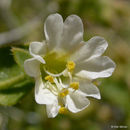Comprehensive Description
(
Inglês
)
fornecido por North American Flora
Hesperonia retrorsa (Heller) Standley
Mirabilis glutinosa A. Nelson, Proc. Biol. Soc. Wash* 17: 92. 1904. Not M. glutinosa Kuntze.
1898. Mirabilis retrorsa Heller, Muhlenbergia 2: 193. 1906. Hesperonia glutinosa Standley, Contr. U. S. Nat. Herb. 12: 365. 1909. Hesperonia glutinosa retrorsa Standley, Contr. U. S. Nat. Herb. 12: 365. 1909. Mirabilis limosa A. Nelson, Bot. Gaz. 47: 426. 1909. Hesperonia limosa Standley, Muhlenbergia 5: 104. 1909. Hesperonia limosa retrorsa Standley, Muhlenbergia 5: 104. 1909. Mirabilis californica glutinosa Jepson, Fl. Calif. 458. 1914. Mirabilis californica retrorsa Jepson, Fl. Calif. 458. 1914.
Plants erect or ascending, suffrutescent at the base, much branched, the branches 3-6 dm. long, slender or stout, with usually elongate internodes, whitish, glabrous below, puberulent above with mostly retrorse hairs, usually slightly viscid and often sparsely shortvillous ; petioles stout, 5-12 mm. long, the uppermost blades often subsessile; blades of the lower leaves ovateorbicular, broadly deltoid-ovate, or suborbicular, 1.5-3.5 cm. long, 1-3 cm. wide, often as broad as long, subcordate or rounded at the base, usually broadly rounded at the apex but rarely narrowed and acutish, the blades of the upper leaves slightly smaller and narrower, obtuse to acute at the apex, all the blades green, thick and succulent, inconspicuously veined, scaberulous or puberulent with mostly retrorse hairs, glabrate in age; peduncles numerous, axillary and crowded at the ends of the branches, those in the lower axils some-
1
times 14 mm. long, the upper ones much shorter, often neariy obsolete; involucre campanulate, 5-7 mm. long, densely viscid-puberulent or short-villous, the lobes shorter than the tube, ovate to ovate-oblong, obtuse or acutish; perianth 10-12 mm. long, white, sparsely viscidpuberulent outside or glabrate; stamens equaling the perianth or slightly exserted; fruit i
broadly oval in outline, 5-6 mm. long, smooth, dark-olive or brown, usually with 10 lighter vertical lines.
Type locality: In Owen's Valley in the extreme southern part of Mono County, California, near the Southern Belle Mine.
Distribution : In dry, chiefly sandy soil, southwestern Utah and western Arizona, and in southeastern California, from Inyo County to San Diego County.
- citação bibliográfica
- Paul Carpenter Standley. 1918. (CHENOPODIALES); ALLIONIACEAE. North American flora. vol 21(3). New York Botanical Garden, New York, NY
Comprehensive Description
(
Inglês
)
fornecido por North American Flora
Hesperonia retrorsa (Heller) Standley
Mirabilis glutinosa A. Nelson, Proc. Biol. Soc. Wash* 17: 92. 1904. Not M. glutinosa Kuntze.
1898. Mirabilis retrorsa Heller, Muhlenbergia 2: 193. 1906. Hesperonia glutinosa Standley, Contr. U. S. Nat. Herb. 12: 365. 1909. Hesperonia glutinosa retrorsa Standley, Contr. U. S. Nat. Herb. 12: 365. 1909. Mirabilis limosa A. Nelson, Bot. Gaz. 47: 426. 1909. Hesperonia limosa Standley, Muhlenbergia S: 104. 1909. Hesperonia limosa retrorsa Standley, Muhlenbergia 5: 104. 1909. Mirabilis californica glutinosa Jepson, Fl. Calif. 458. 1914. Mirabilis californica retrorsa Jepson, Fl. Calif. 458. 1914.
Plants erect or ascending, suffrutescent at the base, much branched, the branches 3-6 dm. long, slender or stout, with usually elongate internodes, whitish, glabrous below, puberulent above with mostly retrorse hairs, usually slightly viscid and often sparsely shortvillous ; petioles stout, 5-12 mm. long, the uppermost blades often subsessile; blades of the lower leaves ovate-orbicular, broadly deltoid-ovate, or suborbicular, 1.5-3.5 cm. long, 1-3 cm. wide, often as broad as long, subcordate or rounded at the base, usually broadly rounded at the apex but rarely narrowed and acutish, the blades of the upper leaves slightly smaller and narrower, obtuse to acute at the apex, all the blades green, thick and succulent, inconspicuously veined, scaberulous or puberulent with mostly retrorse hairs, glabrate in age ; peduncles numerous, axillary and crowded at the ends of the branches, those in the lower axils sometimes 14 mm. long, the upper ones much shorter, often nearly obsolete; involucre campanulate, 5-7 mm. long, densely viscid-puberulent or shortvillous, the lobes shorter than the tube, ovate to ovate-oblong, obtuse or acutish; perianth 10-12 mm. long, white, sparsely viscidpuberulent outside or glabrate; stamens equaling the perianth or slightly exserted; fruit broadly oval in outline, 5-6 mm. long, smooth, dark-olive or brown, usually with 10 lighter vertical lines.
Type locality: In Owen's Valley in the extreme southern part of Mono County, California, near the Southern Belle Mine.
Distribution : In dry, chiefly sandy soil, southwestern Utah and western Arizona, and in southeastern California, from Inyo County to San Diego County.
- citação bibliográfica
- Paul Carpenter Standley. 1918. (CHENOPODIALES); ALLIONIACEAE. North American flora. vol 21(3). New York Botanical Garden, New York, NY

